ClearBoard is designed to integrate interpersonal space and shared workspace seamlessly. A design goal of ClearBoard is to allow a pair of users to shift easily between interpersonal space and shared workspace using familiar everyday cues such as the partner's gestures, head movements, eye contact, and gaze direction.
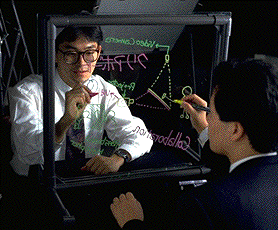 |
The key metaphor of ClearBoard design is "talking through and drawing on a big transparent glass board." This picture shows "ClearBoard-0" which is the simple mockup of this ClearBoard concept for co-located pairs of users. ClearBoard-0 consists of a glass board positioned between the partners on which they draw or post objects. ClearBoard requires less eye and head movement to switch focus between the drawing surface and the partner's face than is needed in either the whiteboard or the desktop environment. However, a real glass board has the problem that written text appears reversed to one's partner; we were able to solve this problem by mirror-reversing video images in ClearBoard-1 and 2 as described below. |
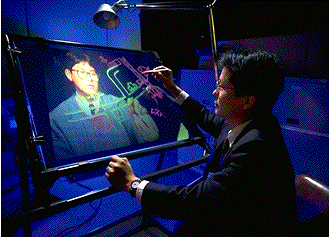 |
This picture shows ClearBoard-1; our first
prototype to support remote collaboration. Two users are discussing a route
by drawing a map directly on the screen surface. Both users can share a
common map orientation. The partner can read all the text and graphics in
their correct orientation. We found ClearBoard provides the capability we call "gaze awareness": the ability to monitor the direction of a partner's gaze and thus his or her focus of attention. A ClearBoard user can tell which screen objects the partner is gazing at during a conversation more easily and precisely than is possible in an ordinary meeting environment with a whiteboard. |
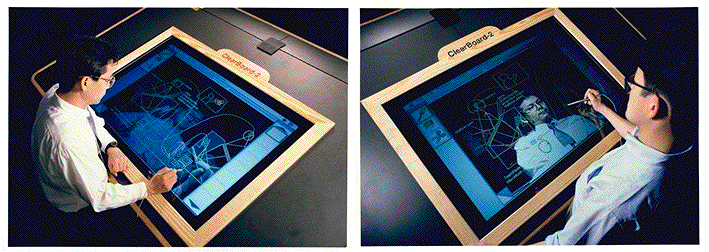 | |
| In using this ClearBoard-1 prototype, we found
several problems. The projected video image of a drawing is not sufficiently
clear. Lack of recording capabilities is an obstacle to re-using the work
results. To overcome these problems in ClearBoard-1, we decided to design
a new computer-based prototype, "ClearBoard-2". Instead of using
color paint markers, ClearBoard-2 provides users with "TeamPaint",
a multi-user computer-based paint editor and digitizer pen. We see the evolution from ClearBoard-1 to ClearBoard-2 as being very important. Computer and video-communication technologies have, until now, evolved independently. Although they have been loosely coupled using arbitrary multi-window interfaces in many desktop multimedia conferencing systems, they have never been integrated seamlessly from the users' cognitive point of view. ClearBoard-2 succeeds in naturally integrating the technology of computer-based groupware with that of video conferencing. We expect that the seamless integration of computer and video communication technologies will be an integral part of the next generation of collaboration media. |
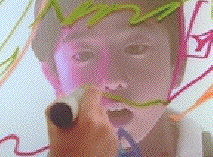 |
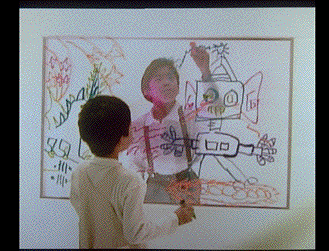 |
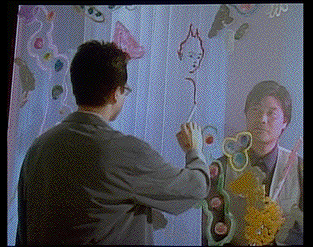 |
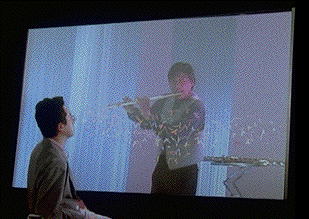 |
| [ images from vision video "Seamless Media Design," SIGGRAPH Video Review, CSCW '94 Technical Video Program, Issue 106, Item 10, ACM, New York, 1994. ] | |
| We are now very much interested in how the next generation of collaboration media may augment the process of collaborative creation by people such as artists, musicians, designers and children. NTT's vision video, "Seamless Media Design" illustrates our expectation of future collaboration media based on the ClearBoard concept. Following picture shows snapshots of a session from the vision video. | |
For more information about this project, please
refer the following papers and videos.
Ishii, H., Kobayashi, M. and Arita, K.,
"Iterative Design of Seamless Collaboration Media," Communications
of the ACM (CACM), Special Issue on Internet Technology, ACM, Vol. 37,
No. 8, August 1994, pp. 83-97.
Ishii, H., Kobayashi, M. and Grudin, J., "Integration of Interpersonal
Space and Shared Workspace: ClearBoard Design and Experiments," ACM
Transactions on Information Systems (TOIS), ACM, Vol. 11, No. 4, October
1993, pp. 349-375.
Kobayashi, M. and Ishii, H., "ClearBoard: A Novel Shared Drawing Medium
that Supports Gaze Awareness in Remote Collaboration," IEICE Transactions
on Communications, Institute of Electronics, Information and Communication
Engineers of Japan (IEICE), Vol. E76-B, No. 6, June 1993, pp. 609-617.
Ishii, H., Kobayashi, M., and Grudin, J., "Integration of Inter-Personal
Space and Shared Workspace: ClearBoard Design and Experiments," Proceedings
of Conference on Computer-Supported Cooperative Work (CSCW '92),
ACM, Toronto, 1-4 November 1992, pp. 33-42.
Ishii, H. and Kobayashi, M., "ClearBoard: A Seamless Media for Shared
Drawing and Conversation with Eye-Contact," Proceedings of Conference
on Human Factors in Computing Systems (CHI '92), ACM SIGCHI, Monterey,
3-7 May 1992, pp. 525-532.
NTT, "Seamless Media Design,"
SIGGRAPH Video Review, CSCW '94 Technical Video Program, Issue 106,
Item 10, ACM, New York, 1994.
Ishii, H., Arita, K., and Kobayashi, M., "Toward Seamless Collaboration
Media: From TeamWorkStation to ClearBoard," SIGGRAPH Video Review,
CSCW '92 Technical Video Program, Issue 87, Item 6, ACM, New York,
1992.